PHYSICAL SCIENCES PHYSICS PAPER 1 GRADE 12 QUESTIONS - AMENDED SENIOR CERTIFICATE EXAM PAST PAPERS AND MEMOS MAY/JUNE 2016
Share via Whatsapp Join our WhatsApp Group Join our Telegram GroupPHYSICAL SCIENCES (PHYSICS)
PAPER ONE (P1)
GRADE 12
AMENDED SENIOR CERTIFICATE EXAM
PAST PAPERS AND MEMOS MAY/JUNE 2016
INSTRUCTIONS AND INFORMATION
- This question paper consists of 11 questions. Answer ALL the questions
- Start EACH question on a NEW page in the ANSWER BOOK.
- Number the answers correctly according to the numbering system used in this question paper.
- Leave ONE line between two subquestions, for example between QUESTION 2.1 and QUESTION 2.2.
- You may use a non-programmable calculator.
- You may use appropriate mathematical instruments.
- You are advised to use the attached DATA SHEETS.
- Show ALL formulae and substitutions in ALL calculations.
- Round off your final numerical answers to a minimum of TWO decimal places.
- Give brief motivations, discussions, et cetera where required.
- Write neatly and legibly.
QUESTIONS
QUESTION 1: MULTIPLE-CHOICE QUESTIONS
Four options are provided as possible answers to the following questions. Each question has only ONE correct answer. Choose the answer and write only the letter (A–D) next to the question number (1.1–1.10) in the ANSWER BOOK, for example 1.11 E.
1.1 An object, of mass m, hangs at the end of a string from the ceiling of a lift cage. The lift is moving upward at CONSTANT SPEED. The acceleration due to gravity is g. 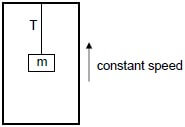
Which ONE of the following statements regarding the tension (T) in the string is CORRECT?
The tension T …
- will be equal to mg.
- will be less than mg.
- will be greater than mg.
- cannot be determined without knowing the speed of the lift cage. (2)
1.2 Two hypothetical planets, X and Y, have the same mass. The diameter of planet Y is twice that of planet X.
If the acceleration due to gravity on the surface of planet X is g, then the acceleration due to gravity on the surface of planet Y will be …
- g/16
- g/4
- g/2
- 2g (2)
1.3 A ball is projected vertically upwards from a height X above the ground. After some time, the ball falls to the ground and bounces back to the same height from which it was projected. Ignore friction and assume that there is a negligible time lapse during the collision of the ball with the ground.
Which ONE of the following is the CORRECT position-time graph for the motion of the ball as described above? 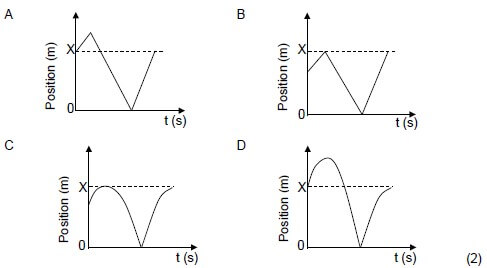
1.4 Which ONE of the following statements is always TRUE for inelastic collisions in an isolated system?
- Both momentum and kinetic energy are conserved.
- Both momentum and kinetic energy are not conserved.
- Momentum is conserved, but kinetic energy not.
- Kinetic energy is conserved, but momentum not. (2)
1.5 When the net work done on an object is positive (greater than zero), the …
- kinetic energy of the object is zero.
- kinetic energy of the object is increasing.
- kinetic energy of the object is decreasing.
- kinetic energy of the object remains unchanged. (2)
1.6 A police car with its siren wailing is moving away from a stationary observer at constant speed. The siren emits a sound of constant frequency.
Which of the following characteristics associated with the sound of the siren, as perceived by the observer, is/are CORRECT?
- The speed remains the same.
- The frequency increases.
- The wavelength increases.
- The pitch decreases.
- (iii) only
- (i), (iii) and (iv)
- (i) and (iii) only
- (i) and (ii) only (2)
1.7 The magnitude of the electric field at a point P from a positive point charge q is x N∙C-1.
Which ONE of the statements below regarding this electric field is CORRECT?
- A + 1 C charge placed at P will experience a force of magnitude x N directed away from q.
- The force on a + 2 C charge placed at P will have a magnitude ¼ x N directed away from q.
- A + 1 C charge placed at P will experience a force of magnitude x N directed towards q.
- The force on a + 2 C charge placed at P will have a magnitude ¼ x N directed towards q. (2)
1.8 Circuit I shows two identical lamps X and Y connected to a cell of negligible internal resistance. Switch S is closed. 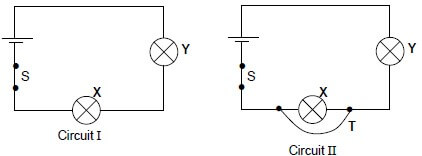
A wire T, of negligible resistance, is now connected across X as shown in Circuit II.
Which ONE of the statements below best describes how the brightness of the lamps have changed after T had been connected?
X | Y | |
A | Does not light up | Dimmer |
B | Brighter | Dimmer |
C | Brighter | Brighter |
D | Does not light up | Brighter |
(2)
1.9 Some learners decided to build a small electrical generator in the laboratory. They then used this generator to investigate how the magnitude of the induced emf would change as the magnetic field strength changed.
Which ONE of the following is CORRECT regarding the variables for the investigation?
DEPENDENT VARIABLE | INDEPENDENT VARIABLE | CONTROL VARIABLE | |
A | Magnitude of induced emf | Number of turns of coil of generator | Magnetic field strength |
B | Number of turns of coil of generator | Magnitude of induced emf | Magnetic field strength |
C | Magnitude of induced emf | Magnetic field strength | Number of turns of coil of generator |
D | Magnetic field strength | Number of turns of coil of generator | Magnitude of induced emf |
(2)
1.10 In an experiment on the photoelectric effect, a scientist shines red light on a metal surface and observes that electrons are ejected from the metal surface. Later the scientist shines blue light, with the same intensity as the red light, on the same metal surface.
Which ONE of the statements below will be the CORRECT observation as a result of this change?
- The number of ejected electrons per second will increase.
- The number of ejected electrons per second will decrease.
- The speed of the ejected electrons will decrease.
- The maximum kinetic energy of the ejected electrons will increase. (2)
[20]
QUESTION 2 (Start on a new page.)
The diagram below shows a 10 kg block lying on a flat, rough, horizontal surface of a table. The block is connected by a light, inextensible string to a 2 kg block hanging over the side of the table. The string runs over a light, frictionless pulley.
The blocks are stationary.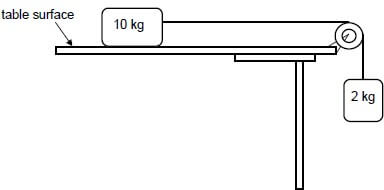
2.1 State Newton's FIRST law in words. (2)
2.2 Write down the magnitude of the NET force acting on the 10 kg block. (1)
When a 15 N force is applied vertically downwards on the 2 kg block, the 10 kg block accelerates to the right at 1,2 m∙s-2.
2.3 Draw a free-body diagram for the 2 kg block when the 15 N force is applied to it. (3)
2.4 Calculate the coefficient of kinetic friction between the 10 kg block and the surface of the table. (7)
2.5 How does the value, calculated in QUESTION 2.4, compare with the value of the coefficient of STATIC friction for the 10 kg block and the table? Write down only LARGER THAN, SMALLER THAN or EQUAL TO. (1)
2.6 If the 10 kg block had a larger surface area in contact with the surface of the table, how would this affect the coefficient of kinetic friction calculated in QUESTION 2.4? Assume that the rest of the system remains unchanged. Write down only INCREASES, DECREASES or REMAINS THE SAME. Give a reason for the answer. (2) [16]
QUESTION 3 (Start on a new page.)
Ball A is projected vertically upwards from the ground, near a tall building, with a speed of 30 m∙s-1. Ignore the effects of air friction.
3.1 Explain what is meant by a projectile. (2)
3.2 Calculate:
3.2.1 The total time that ball A will be in the air (4)
3.2.2 The distance travelled by ball A during the last second of its fall (4)
3.3 TWO SECONDS after ball A is projected upwards, ball B is projected vertically upwards from the roof of the same building. The roof the building is 50 m above the ground. Both balls A and B reach the ground at the same time. Refer to the diagram below. Ignore the effects of air friction.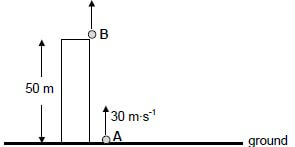
Calculate the speed with which ball B was projected upwards from the roof. (4)
3.4 Sketch velocity-time graphs for the motion of both balls A and B on the same set of axes. Clearly label the graphs for balls A and B respectively.
Indicate the following on the graphs:
- Time taken by both balls A and B to reach the ground
- Time taken by ball A to reach its maximum height (4)
[18]
QUESTION 4 (Start on a new page.)
The diagram below shows two sections, XY and YZ, of a horizontal, flat surface. Section XY is smooth, while section YZ is rough.
A 5 kg block, moving with a velocity of 4 m∙s-1 to the right, collides head-on with a stationary 3 kg block. After the collision, the two blocks stick together and move to the right, past point Y.
The combined blocks travel for 0,3 s from point Y before coming to a stop at point Z. 4 m∙s-1 0 m∙s-1 
4.1 State the principle of conservation of linear momentum in words. (2)
4.2 Calculate the magnitude of the:
4.2.1 Velocity of the combined blocks at point Y (4)
4.2.2 Net force acting on the combined blocks when they move through section YZ (4) [10]
QUESTION 5 (Start on a new page.)
A 20 kg block is released from rest from the top of a ramp at point A at a construction site as shown in the diagram below.
The ramp is inclined at an angle of 30o to the horizontal and its top is at a height of 5 m above the ground. 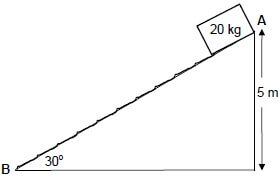
5.1 State the principle of conservation of mechanical energy in words. (2)
5.2 The kinetic frictional force between the 20 kg block and the surface of the ramp is 30 N.
Use energy principles to calculate the:
5.2.1 Work done by the kinetic frictional force on the block (3)
5.2.2 Speed of the block at point B at the bottom of the ramp (5)
5.3 A 100 kg object is pulled up the SAME RAMP at a constant speed of 2 m∙s-1 by a small motor. The kinetic frictional force between the 100 kg object and the surface of the ramp is 25 N.
Calculate the average power delivered by the small motor in the pulling of the object up the incline. (4) [14]
QUESTION 6 (Start on a new page.)
An ambulance is travelling towards a hospital at a constant velocity of 30 m∙s-1. The siren of the ambulance produces sound of frequency 400 Hz. Take the speed of sound in air as 340 m∙s-1.
The diagram below shows the wave fronts of the sound produced from the siren as a result of this motion. 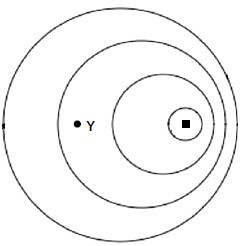
6.1 At which side of the diagram, X or Y, is the hospital situated? (1)
6.2 Explain the answer to QUESTION 6.1. (3)
6.3 Calculate the frequency of the sound of the siren heard by a person standing at the hospital. (5)
6.4 A nurse is sitting next to the driver in the passenger seat of the ambulance as it approaches the hospital. Calculate the wavelength of the sound heard by the nurse. (3)
[12]
QUESTION 7 (Start on a new page.)
A small sphere, Q1, with a charge of + 32 x 10-9 C, is suspended from a light string secured to a support. A second, identical sphere, Q2, with a charge of – 55 x 10-9 C, is placed in a narrow, cylindrical glass tube vertically below Q1. Each sphere has a mass of 7 g. Both spheres come to equilibrium when Q2 is 2,5 cm from Q1, as shown in the diagram. Ignore the effects of air friction. 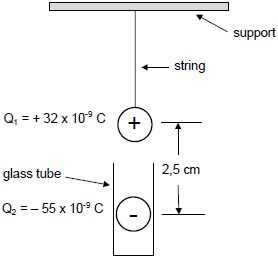
7.1 Calculate the number of electrons that were removed from Q1 to give it a charge of + 32 x 10-9 C. Assume that the sphere was neutral before being charged. (3)
7.2 Draw a labelled free-body diagram showing all the forces acting on sphere Q1. (3)
7.3 Calculate the magnitude of the tension in the string. (5)
[11]
QUESTION 8 (Start on a new page.)
8.1 Define electric field at a point in words. (2)
8.2 Draw the electric field pattern for two identical positively charged spheres placed close to each other. (3)
8.3 A – 30 μC point charge, Q1, is placed at a distance of 0,15 m from a + 45 μC point charge, Q2, in space, as shown in the diagram below. The net electric field at point P, which is on the same line as the two charges, is zero. ![]()
Calculate x, the distance of point P from charge Q1. (5)
[10]
QUESTION 9 (Start on a new page.)
9.1 In the diagram below, three light bulbs, A, B and C, are connected in parallel to a 12 V source of negligible internal resistance. The bulbs are rated at 4 W, 6 W and 10 W respectively and are all at their maximum brightness. 
9.1.1 Calculate the resistance of the 4 W bulb. (3)
9.1.2 How will the equivalent resistance of the circuit change if the 6 W bulb burns out? Write down only INCREASES, DECREASES or NO CHANGE. (1)
9.1.3 How will the power dissipated by the 10 W bulb change if the 6 W bulb burns out? Write down only INCREASES, DECREASES or NO CHANGE. Give a reason for the answer. (2)
9.2 A learner connects a high-resistance voltmeter across a battery. The voltmeter reads 6 V. She then connects a 6 Ω resistor across the battery. The voltmeter now reads 4, 5 V.
9.2.1 Calculate the internal resistance of the battery. (4)
The learner now builds the circuit below, using the same 6 V battery and the 6 Ω resistor. She connects an unknown resistor X in parallel with the 6 Ω resistor. The voltmeter now reads 4,5 V.
9.2.2 Define the term emf of a cell. (2) 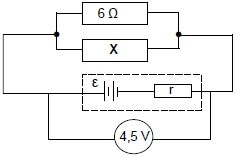
9.2.3 Calculate the resistance of X when the voltmeter reads 4,5 V. (5)
[17]
QUESTION 10 (Start on a new page.)
10.1 A part of a simplified DC motor is shown in the sketch below. 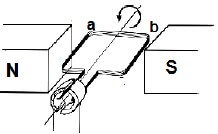
10.1.1 In which direction (a to b, OR b to a) is the current flowing through the coil if the coil rotates anticlockwise as indicated in the diagram? (1)
10.1.2 Name the rule you used to answer QUESTION 10.1.1. (1)
10.1.3 Which component in the diagram must be replaced in order for the device to operate as an AC generator? (1)
10.2 An electrical device of resistance 400 Ω is connected across an AC generator that produces a maximum emf of 430 V. The resistance of the coils of the generator can be ignored.
10.2.1 State the energy conversion that takes place when the AC generator is in operation. (2)
10.2.2 Calculate the root mean square value of the current passing through the resistor. (5)
[10]
QUESTION 11 (Start on a new page.)
11.1 In an experiment on the photoelectric effect, light is incident on the surface of a metal and electrons are ejected.
11.1.1 What does the photoelectric effect indicate about the nature of light? (1)
11.1.2 The intensity of the light is increased. Will the maximum speed of the ejected electrons INCREASE, DECREASE or REMAIN THE SAME? Give a reason for the answer. (2)
The wavelength corresponding with the threshold frequency is referred to as threshold wavelength.
The table below gives the values of threshold wavelengths for three different metals.
METAL | THRESHOLD WAVELENGTH (λ0) IN METRES |
Silver | 2,88 x 10-7 |
Calcium | 4,32 x 10-7 |
Sodium | 5,37 x 10-7 |
In the experiment using one of the metals above, the maximum speed of the ejected electrons was recorded as 4,76 x 105 m·s-1 for light of wavelength 420 nm.
11.1.3 Identify the metal used in the experiment by means of suitable calculations. (5)
11.2 The simplified energy diagrams showing the possible electron transitions in an atom are shown below. 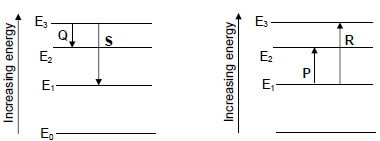
Using the letters P, Q, R and S, identify the lines that CORRECTLY show transitions that will result in the atom giving off an EMISSION SPECTRUM. Give a reason for the answer. (4)
[12]
TOTAL: 150
DATA FOR PHYSICAL SCIENCES GRADE 12
PAPER 1 (PHYSICS)
TABLE 1: PHYSICAL CONSTANTS
NAME | SYMBOL | VALUE |
Acceleration due to gravity | g | 9,8 m·s-2 |
Universal gravitational constant | G | 6,67 x 10-11 N·m2·kg-2 |
Radius of the Earth | RE | 6,38 x 106 m |
Mass of the Earth | ME | 5,98 x 1024 kg |
Speed of light in a vacuum | c | 3,0 x 108 m·s-1 |
Planck's constant | h | 6,63 x 10-34 J·s |
Coulomb's constant | k | 9,0 x 109 N·m2·C-2 |
Charge on electron | e | –1,6 x 10-19 C |
Electron mass | me | 9,11 x 10-31 kg |
TABLE 2: FORMULAE
MOTION
v f = v i + a ∆ t | ∆x = v1∆t + ½a∆t2 or ∆y = v1∆t + ½a∆t2 |
| vf2 = v i 2+ 2a ∆ x or vf2 = v i 2+ 2a ∆ y | ∆x = [v1 + vf] ∆t or ∆y = [v1 + vf] ∆t 2 2 |
FORCE
Fnet = ma | p= mv |
fsmax = μsN | fk =μkN |
Fnet∆t = ∆p | w =mg |
| F = G M1M2 or F = G M1M2 d2 r2 | g = GM/d2 or g = GM/r2 |
WORK, ENERGY AND POWER
W = F∆x cos θ | U= mgh or EP = mgh |
K = ½mv2 or Ek = ½mv2 | Wnet = ∆K or Wnet = ∆Ek |
Wnc = ∆K + ∆U or Wnc = ∆Ek + ∆Ep | P=W/∆t |
Pave = Fvave / Pgemid = Fvgemid |
WAVES, SOUND AND LIGHT
v = f λ | T = 1/f |
| fl = v ± vl fs or fl = v ± vl fb v ± vs v ± vb | E= hf or E = hc/λ |
| E = WO + Ek(max) or E= WO + Ek(max) where E = hf and WO = hfo and Ek(max) = ½mv2max or k(max) = ½mv2max | |
ELECTROSTATICS
| F = kQ1Q2 r2 | E = kQ r2 |
| V = W/q | E = F/Q |
| n = Q/e or n = Q/qe |
ELECTRIC CIRCUITS
R = V/I | emf ( ε ) = I(R + r) |
Rs = R1 + R2 + ... | q = I∆t |
W = Vq | P = W/∆t |
ALTERNATING CURRENT
 |  |